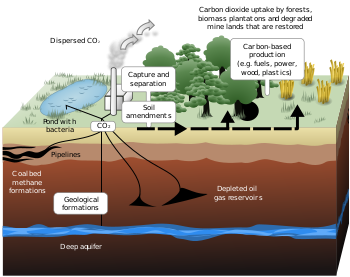 |
| Schematic showing both terrestrial and geological sequestration of carbon dioxide emissions from a coal-fired plant. Rendering by LeJean Hardin and Jamie Payne. Source: http://www.ornl.gov/info/ornlreview/v33_2_00/research.htm (Photo credit: Wikipedia) |
The Paris Agreement did not explicitly mention geoengineering as a solution, in addition to efforts to reduce carbon emissions, to the challenges involved in reaching the ultimate goal of end to global warming and a stable radiation equilibrium,. Geoengineering may be broken down into two approaches: carbon dioxide removal (CDR) (as shown, for example, by carbon capture and sequestration) and solar radiation management (SRM) (as shown, for example, by the introduction of aerosols into the atmosphere to reflect incoming solar radiation). The authors of the paper reviewed here flag several indirect references to CDR in the Paris agreement as well as suggesting the inevitability of SRM, if there is any chance of meeting the very challenging objective of limiting warming to 1.5 C or less. They noted that CDR comes with a high short term cost while SRM does not but could limit warming to 1.5 C- although SRM comes with much more uncertainty when it comes to side effects and governance issues.
Key Quotes:
“We survey the implications of the revamped climate policy regime for carbon removal and solar geoengineering, hereafter referred to using the common acronyms carbon dioxide removal (CDR) and solar radiation management (SRM).”
“The scope of “mitigation” activities under the Agreement explicitly includes removal of carbon dioxide: Article 4 calls for achieving “a balance between anthropogenic emissions by sources and removals by sinks of greenhouse gases in the second half of this century.”
“Although it does not call for CDR[carbon dioxide removal] per se, core elements of the Agreement…are based on the assumption that CDR will be widely used to help reduce atmospheric concentrations of CO2 over the coming century.”
“some forms of SRM[solar radiation management], such as the injection of reflective aerosols in the stratosphere, would reduce global radiative forcing and surface temperatures….this reduction in radiative forcing carries with it new risks and uncertainties, and there is no sense in which increasing the Earth’s reflectivity is the equivalent of reducing carbon dioxide concentrations.“
“analysis using state-of-the-art climate models has shown that under moderate amounts of SRM…almost all regions of the world would experience climates closer to preindustrial conditions with SRM compared to what they would experience without it”
"the fact that the Agreement contains explicit quantitative temperature goals instead of, say, an explicit carbon budget goal (due largely to continuing objections from oil-exporting states) actually facilitates the eventual inclusion of SRM in the post-Paris system”
“the economics of CDR are, in fact, very similar to those of emissions mitigation: both entail high, local, short-term costs that discourage widespread deployment.”
“These obstacles, however, do not apply to SRM, which models demonstrate would be capable of limiting global warming to 1.5 °C above preindustrial levels (if this were desired in the future), albeit with known and likely unknown side effects and serious governance challenges. “






No comments:
Post a Comment